| |

Traditions, folklore, history and more. If it's Irish, it's here. Or will be!
"People will not look forward to posterity who never look backward to their ancestors."
-Edmund Burke




Quotes
Library: Books, Movies, Music
Prints & Photos
Poetry
Jokes


Shops Ireland
Bunús na Gaeilge
(Basic Irish)
Circle of Prayer
Blessings
Did You Know?
Himself/Herself
Write to Us
Readers Write..
Links/Link to Us
Advertise with us
Awards & Testimonials
Submissions Guide

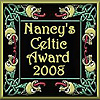
|
|
|
Our Lady of Knock Shrine - Place of Mystery and Miracles
by Bridget Haggerty
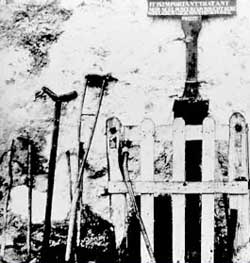 Cured pilgrims still leave their sticks and crutches by the Apparition gable - evidence of the healing power of Knock. Cured pilgrims still leave their sticks and crutches by the Apparition gable - evidence of the healing power of Knock.
On the evening of Thursday, 21 August 1879, two women from the small village of Knock, Mary McLoughlin and Mary Beirne, were walking back to their home in the rain when they passed by the back of the village church. It was then that they saw the apparition.
Our Lady, St. Joseph and St. John the Evangelist appeared at the South gable of the church. Mary wore a large white cloak, fastened at the neck. Her hands and eyes were raised towards heaven, in a posture of prayer. On her head was a brilliant crown and where the crown fitted the brow, was a gold rose. On her right was St. Joseph, head bowed and turned slightly towards her as if paying her his respects. He wore white robes. On Mary's left was St. John the Evangelist, dressed as a bishop, with a book in his left hand and right hand, raised as if preaching. His robes were also white. Beside the figures and a little to the right in the centre of the gable was a large plain altar. On the altar stood a lamb, facing the west and behind the lamb a large cross stood upright. Angels hovered around the lamb for the duration of the apparition.
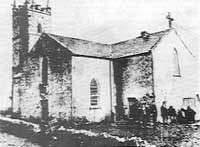 The women called several other people to the church and they too, saw the apparition. In all, there were fifteen official witnesses. They included men, women and children of various ages. They watched the apparition for about two hours, in the pouring rain, and recited the Rosary. It was so real that one elderly lady, Brigid Trench, went up to the gable and tried to kiss the feet of Our Lady. She is quoted as saying: The women called several other people to the church and they too, saw the apparition. In all, there were fifteen official witnesses. They included men, women and children of various ages. They watched the apparition for about two hours, in the pouring rain, and recited the Rosary. It was so real that one elderly lady, Brigid Trench, went up to the gable and tried to kiss the feet of Our Lady. She is quoted as saying:
"Céad mile ouiochas le Dia agus leis an Maighdin ghlórmhair a thug dúinn an talspednadh seo."
Bríd Ní Thrinsigh. (Finné)
"A hundred thousand thanks to God and to the glorious Virgin that has given us this manifestation."
Brigid Trench. (Witness)
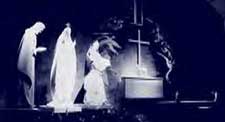 Other villagers, who were not involved with the apparition reported seeing a very bright light illuminating the area around where the church was located. And, there were subsequent reports of inexplicable healings associated with visits to the site. Other villagers, who were not involved with the apparition reported seeing a very bright light illuminating the area around where the church was located. And, there were subsequent reports of inexplicable healings associated with visits to the site.
Ten days after the first apparition, the first cure occurred. Twelve year old Delia Gordon, the daughter of P. J. Gordon of Claremorris, was suffering from severe ear problems. While at the apparition site, Delia complained of pain in her left ear. The following is what Mrs. Gordon told a reporter during an interview at the Shrine: "After the apparition, I brought Delia here to Knock with me to Mass. While we were in the church the pain in her ear attacked her so violently that she began to cry. I brought her out to the gable and bade her to pray. I took the pin of my shawl, picked out a little of the cement from the apparition wall and put it in her ear. At that moment a friend came up and spoke to me. She went away in a few minutes. I turned back and asked the child, 'Well Delia, how is the pain?' She said, 'Tis gone, mamma.' She never had a pain to trouble her since. “
Now, Mrs. Gordon might not be responsible for having started the trend of using cement for cures, but soon the entire apparition wall was torn apart by pilgrims chipping out the cement, mortar, and stones for souvenirs and to use for cures. This is described by a reporter in an interview with Archdeacon Cavanagh, which was published February 14, 1880, as follows:
"In the course of our interview, Archdeacon Cavanagh tells me of the eagerness of the people, who come in multitudes from far and near to possess themselves of fragment of cement or mortar from the wall of the southern gable.
"When the cement that is near to hand has been entirely picked away, the mortar is rooted out from between the stones, and then the stones themselves are detached, and in a few days a large hole appears in the wall. A second hole is soon made.
"A sheathing of planks has to be put up, or the wall will rapidly disappear.” The Archdeacon goes on to speak of several cases in which persons undergoing some form of bodily suffering, who applied, water in which some cement had been dissolved, or had drunk water collected from the ground in front of the gable, were cured, or at lest afforded much relief”.
At the end of 1880, some 300 cures, apparently miraculous, had been recorded in the diary of the parish priest. One of the pilgrims, who had been cured soon after the apparition, testified many years later that he had seen "as many as half-a-dozen pilgrims simultaneously undergoing their cure, or getting relief, and in vision I see the lame walk, my case included, the sightless seeing, the withered skins expanding."
As the news of the apparition and subsequent cures spread, pilgrims by the thousands flocked to the shrine. Those who claimed a cure left their crutches and canes at the site, and many of those supports were attached to the wall.
Commission of Enquiry 1879
Most Rev. Dr. John MacHale, Archbishop of Tuam, only six weeks after the Apparition, set up a Commission of Enquiry. The fifteen witnesses were examined and the Commission reported that the testimony of all, taken as a whole, was trustworthy and satisfactory.
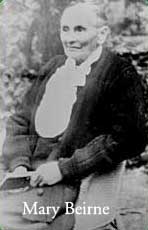 Commission of Enquiry 1936 Commission of Enquiry 1936
Archbishop Gilmartin set up another Commission in 1936 to examine the three surviving witnesses of the Apparition: Mrs. Mary O'Connell (Mary Beirne), Patrick Beirne and John Curry. All three confirmed their original statements of 1879. Mrs O'Connell gave evidence under oath from her death bed and at the end of her statement she added: "I am quite clear about everything I have said, and I make this statement knowing I am going before my God."
The verdict of this Commission was that the evidence of the witnesses was upright and trustworthy, and concerning Mrs. O'Connell, it was reported that she left 'a most favourable impression on their minds'.
Four recent popes have honored Knock. Pius XII blessed the Banner of Knock at St. Peter's and decorated it with a special medal on All Saints' Day, 1945. On this occasion, the Pope announced the new feast of the Queenship of Mary.
Pope John XXIII presented a special candle to Knock on Candlemas Day in 1960. He had always regarded it as one of outstanding shrines devoted to Our Lady.
Pope Paul VI blessed the foundation stone for the Basilica of Our Lady, Queen of Ireland, on June 6, 1974.
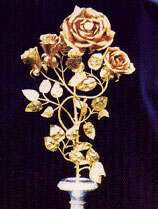 The personal pilgrimage of Pope John Paul II in 1979, commemorating the centenary of the apparition, inspired an even greater devotion to the Shrine and endorsed the indelible seal of Vatican approval. He addressed the sick and the nursing staff, celebrated Mass, established the shrine church as a basilica, presented a candle and the Golden Rose to the shrine, and finally knelt in prayer at the apparition wall. The Golden Rose is now prominently displayed in a glass case in a wall near the original church gable where it is believed Our Lady appeared.
The personal pilgrimage of Pope John Paul II in 1979, commemorating the centenary of the apparition, inspired an even greater devotion to the Shrine and endorsed the indelible seal of Vatican approval. He addressed the sick and the nursing staff, celebrated Mass, established the shrine church as a basilica, presented a candle and the Golden Rose to the shrine, and finally knelt in prayer at the apparition wall. The Golden Rose is now prominently displayed in a glass case in a wall near the original church gable where it is believed Our Lady appeared.
Many other spiritual leaders have visited the shrine, including Mother Teresa of Calcutta who came in June of 1993.
The original Church still stands, but a new Apparition Chapel with statues of Our Lady, St. Joseph, the lamb and St. John the Evangelist has been built next to it. Knock Basilica is a separate building showing a tapestry of the Apparition. There are still plenty of invalids visiting and daily processions with Stations of the Cross. There have been several additions to the site, including a statue of St. Therese and a Folk Museum.
Do miracles still occur at Knock? This lovely story from one of our readers may seem like a coincidence - but it holds very special significance for Maureen Kennedy and her husband Kent.
"The first time I went to Ireland with my husband Kent, we went to Knock. Deciding to get a year of Masses held for both our deceased fathers we went to a little building to sign up (this is where you make your donation and get a card stating who the Masses will be said for). While inside this building (the door was open) and waiting in line, I said to Kent "wouldn't it be wonderful if we knew our Dads knew each other in heaven...." At that moment, two butterflies flew into the building; they circled around our heads twice and then flew out. Needless to say we were moved to tears."
An interesting note about butterflies: In the folklore of many cultures, including Ireland, butterflies often symbolize the soul. One Gaelic tradition says that a recently deceased person might sometimes be visible in the form of a butterfly, hovering over his or her earthly remains. This was a sign of everlasting happiness for the soul.
To read about the annual Novena, please click: Our Lady of Knock Annual Novena.
Resources:
We are most grateful to Maureen and Kent Kennedy for sharing their experience at Knock and to Patricia Edwards for her information about the book, "I Saw Our Lady".
Other Sources - Content & Images:
Our Lady of Knock Shrine
Mayo on The Move
|
|
Fri, Sep 27, 2024
 The Galway Hooker The Galway Hooker
This unique vessel, with its distinctive curved lines and bright red sails, originated in the village of Claddagh. During the 19th century, hookers supported a significant fishing industry and also carried goods, livestock and fuel. Seán Rainey is remembered for building the last of the original boats, the Truelight, for Martin Oliver who was to become the last king of the Claddagh; as king, he was entitled to white sails on his boat. Since the mid seventies, many of the old sailing craft which were on the verge of extinction have been lovingly restored and new ones have been built. During the summer months they can be seen at festivals such a Cruinniú na mBád - the Gathering of the Boats - in Kinvara.
Click for More Culture Corner.
This best-selling book covers the origins of Knock as a shrine and makes extensive use of reports from the leading newspapers of the day. Within its pages, the reader can savour all the principal happenings of the first year of its history. The book is well illustrated with many old photographs and modern colour prints, and there are generous helpings of verse, both old and new. It's sold in the bookshop at Knock, but if you can't visit the shrine, we did a search and found it on amazon UK. Please note - they will ship to an overseas address.
Click here for I saw Our Lady.
|
|
|
|
|




 The Galway Hooker
The Galway Hooker